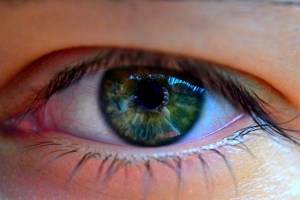 by Witold Fitz-Simon
Eye strain is an increasing problem for many of us in our digital world. Our eyes were not built to be constantly staring at a fixed point with a bright light shining straight at them for several hours at a time. They are, in fact, incredibly skilled at tracking the movement of all the things in our environment, as well as moving around themselves, but once you fix your gaze on something for an extended period of time, all sorts of mechanisms can start to go wrong.
by Witold Fitz-Simon
Eye strain is an increasing problem for many of us in our digital world. Our eyes were not built to be constantly staring at a fixed point with a bright light shining straight at them for several hours at a time. They are, in fact, incredibly skilled at tracking the movement of all the things in our environment, as well as moving around themselves, but once you fix your gaze on something for an extended period of time, all sorts of mechanisms can start to go wrong.
Constant Movement
We see by the light from our environment falling on our eyes which is then directed to the retina, a layer of specialized cells lining the inner surface of our eyeballs, which change the information carried by the light into signals that our brains can process. If a particular image falls on the retina without moving for a while, those light receptors start to get tired and no longer send information, so the muscles of your eyes cause them to constantly jiggle a very tiny amount in a movement called saccades. This means that the light falling on your retinas is shifting around just enough to keep the receptor cells fresh. If your eye muscles become tense and rigid, then that movement is going to be restricted and your eyes will have to work that much harder just to see what is in front of you.
Staring at a bright screen has the additional effect of causing us to blink less. Blinking is an extremely important physiological process. Not only does it effectively wipe the surface of your eyeball, clearing it of accumulated residue from the atmosphere around you, but it also spreads your tears around, keeping your eyes lubricated and hydrated. Once they start to dry out, they become much more prone to irritation.
Relief for Your Eyes
If you find yourself suffering from eye strain, Constructive Rest is a simple and effective practice you can use to help find relief. To learn more about how to set up Constructive Rest and what it can do for you, check out this post. Once you’ve done that, come back here and follow these instructions. (You can also follow them right now at your desk.)
- Close your eyes for a moment and notice how tense they are. Do your eyelids close easily? Are your eyes darting around behind them, or are they fixed in place?
- Place your palms over your eyes for several moments. The contact of your palms and the darkness of having your eyes covered will help them start to recover.
- Once your arms start to get tired from being held up against your face, let them rest by your sides.
- Allow your eyes to open and expand your gaze all the way out into the periphery of your vision.
- Take a few moments to think about allowing your neck to be free. Just think about it, though. Don’t move it around and try to stretch it out.
- As you think of your neck being free, allow your head to be poised on the top of your spine. If you are lying down, allow its weight to be supported by the books underneath it.
- Allow your whole torso to soften and widen and deepen.
- Allow your arms and legs to ease out away from your torso.
- Notice the state of your eyes once again. Are they as tight and as gripped as they were? If they are, don’t worry about it. Come back to allowing yourself to be generally softer and freer.
- Instead of staring out at the room around you, allow the light of the room to come to you. Allow it to fall on your eyes and to be taken back into the visual centers at the back of your brain. I say “allow” because this is happening anyway, but sometimes we do things that get in the way of even unconscious and automatic processes of the body.
- Allow your eyes to move around freely rather than being held fixed in one place. In particular, allow your gaze to rest on things that are different distances away from you as a change from staring at one fixed point over and over again. Stay like this for several minutes.
If you make a point of doing this once or twice a day, over a period of time you can begin to retrain yourself to use your eyes in a more healthy way.
If you suffer from a lot of eye strain or other work-related issues, a trained Alexander Technique teacher can help you change your habits and make your working environment easier and less stressful. Find a certified Alexander Technique teacher in your area here.
[author] [author_image timthumb='on']http://www.acatnyc.org/main/wp-content/uploads/2014/01/After-crop1.jpg[/author_image] [author_info]WITOLD FITZ-SIMON has been a student of the Alexander Technique since 2007. He is certified to teach the Technique as a graduate of the American Center for the Alexander Technique’s 1,600-hour, three year training program. A student of yoga since 1993 and a teacher of yoga since 2000, Witold combines his extensive knowledge of the body and its use into intelligent and practical instruction designed to help his students free themselves of ineffective and damaging habits of body, mind and being. <a href="www.mindbodyandbeing.com">www.mindbodyandbeing.com</a>[/author_info] [/author]
